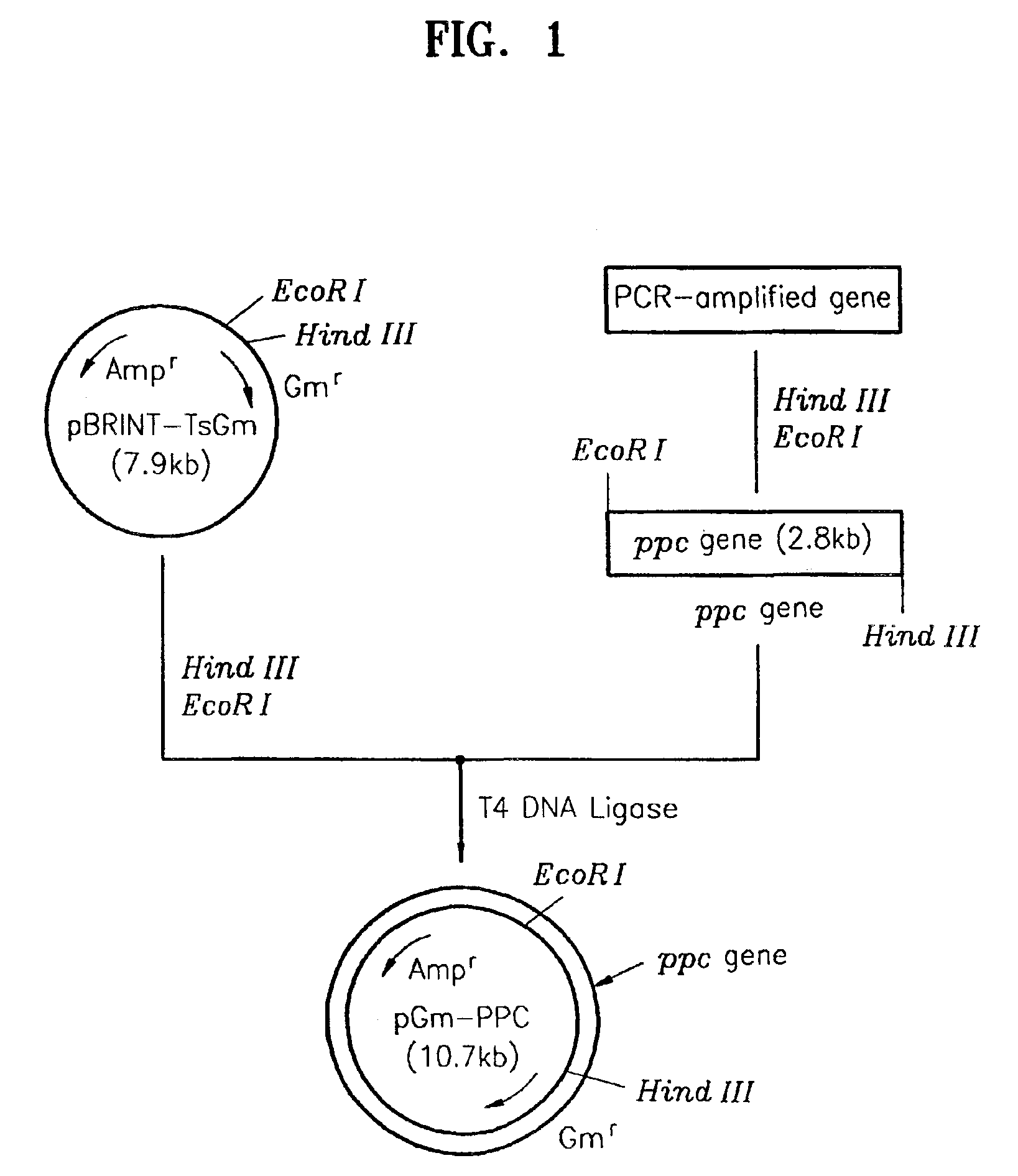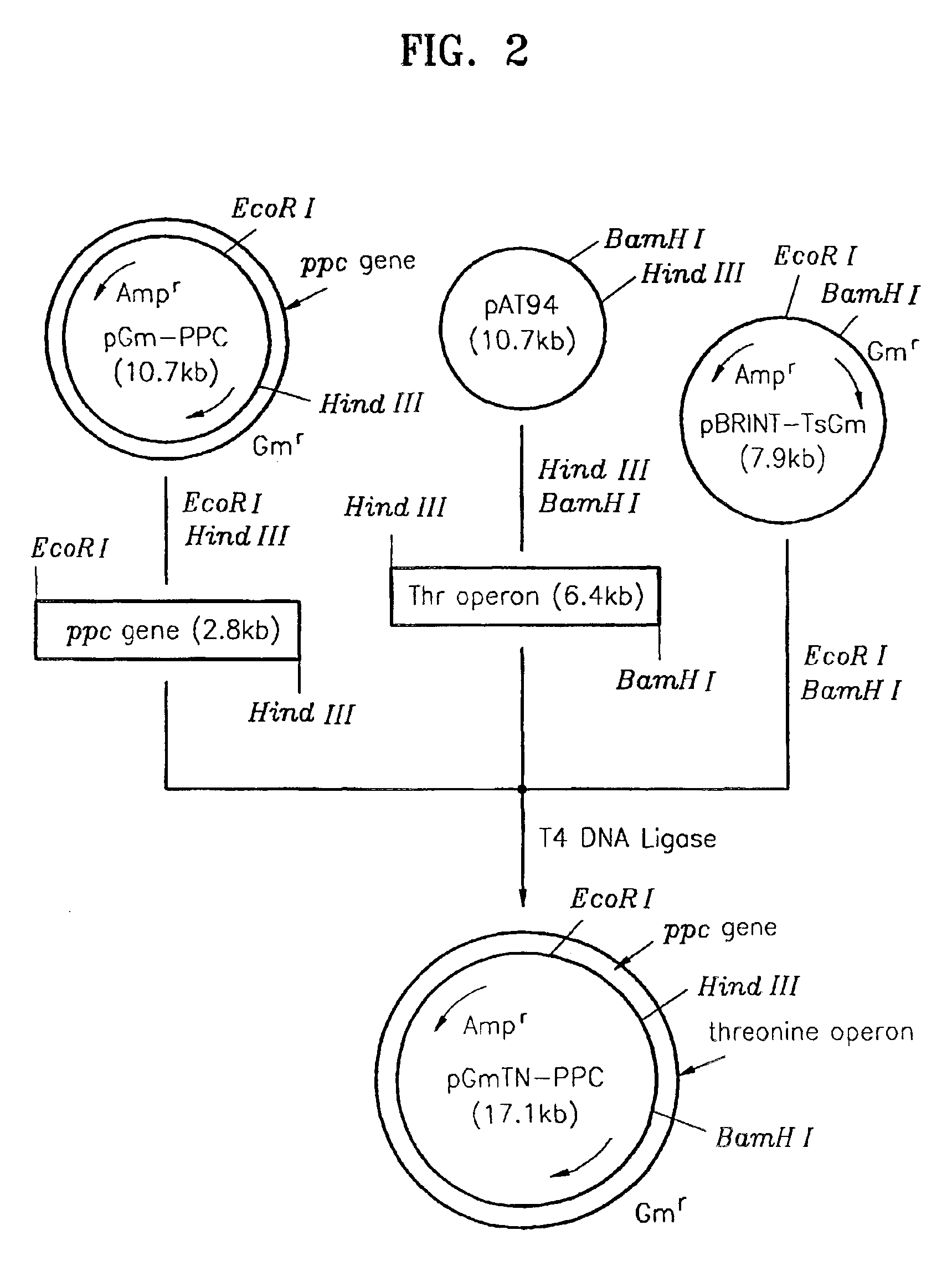Method for L-threonine production
a technology of lthreonine and production method, which is applied in the direction of lyase, transferase, enzymology, etc., can solve the problems of plasmid loss, difficult to increase the yield of primary metabolites, and hardly expected to significantly increase the expression of the threonine operon gene, so as to eliminate the problem of plasmid instability, increase the expression of the phosphoenolpyruvate carboxylas
- Summary
- Abstract
- Description
- Claims
- Application Information
AI Technical Summary
Benefits of technology
Problems solved by technology
Method used
Image
Examples
example 1
Cloning of Phosphoenolpyruvate Carboxylase Gene
[0028]The process of cloning the phosphoenolpyruvate carboxylase (ppc) gene is illustrated in FIG. 1. The ppc gene was obtained from a threonine producing strain, TF 4076. Chromoromal DNA was isolated, digested with restriction enzyme Sal I, and subjected to electrophoresis to selectively isolate 4-5 kb DNA fragments. The ppc gene was amplified by using the isolated DNA fragments as templates and using primer 1 (5′-aggaattcttccgcagcatttgacgtcac-3′) and primer 2 (5′-aggaagcttttagccggtattacgcatacc-3′). The amplified product was digested with EcoR I and Hind III and subjected again to electrophoresis to finally isolate a 2.8 kb ppc gene fragment. A 7.6 kb pBRINT-TsGm, a kind of pBRINT-Ts vectors, from the National University of Mexico was used for cloning (Sylvie Le Beatriz et al., 1998, pBRINT-Ts: A plasmid family with a temperature-sensitive replicon, designed for chromosomal integration into the lacZ gene of Escherichia coli., Gene., 22...
example 2
Chromosomal DNA Integration Vector with Threonine Operon and ppc Gene
[0029]Recombinant plasmid vector pAT94 (Korean Patent Application No. 92-24732) constructed by cloning with the chromosomal DNA of TF4076, was used for the threonine operon, and recombinant plasmid pGmPPC from Example 1 was used for the ppc gene. pBRINT-TsGm, a kind of pBRINT-Ts vectors, from the National University of Mexico was used as a chromosomal DNA integration vector (Sylvie Le Beatriz et al., 1998, pBRINT-Ts: A plasmid family with a temperature-sensitive replicon, designed for chromosomal integration into the lacZ gene of Escherichia coli., Gene., 223, pp. 213-219). A process of construction of a recombinant plasmid is illustrated in FIG. 2. pAT94 was double digested with restriction enzymes Hind III and BamH I, and 6.4 kb threonine operon DNA fragments were isolated from the double digest by electrophoresis. pGmPPC was double digested with Hind III and EcoR I to isolate 2.8 kb ppc gene fragments. pBRINT-Ts...
example 3
Screen of Strain Integrated with Chromosomal Recombinant-plasmid
[0030]TF4076, a threonine producing strain, was transformed with the recombimant plasmid pGmTN-PPC isolated from E. coli strain DH5α, cultured on LB solid medium [yeast extract 5 g / L; bactotryptone 10 g / L; sodium chloride 10 g / L; bactoagar 1.7%; pH 7.0] containing 5 mg / L of gentamycin, and cultivated for 60 hours at 30° C. Each single colony was inoculated into 0.5 mL of LB and incubated for 4 hours at 30° C. An aliquot of the culture was transferred into 10 mL of LB, incubated for 6 hours at 30° C. and then overnight at 37° C. A 10−3-10−6 dilution of the culture was inoculated on LB solid medium containing 5 mg / L of gentamycin. At this time, 12 μL of IPTG (0.1M) and 60 μL of X-gal (2%) were also inoculated on the LB solid medium. After 24-hour incubation at 44° C., recombinant strains were screened for white colonies sensitive to carbenicillin, which cannot grow on the LB solid medium containing 15 mg / L of carbenicilli...
PUM
| Property | Measurement | Unit |
|---|---|---|
| temperature | aaaaa | aaaaa |
| temperature | aaaaa | aaaaa |
| concentration | aaaaa | aaaaa |
Abstract
Description
Claims
Application Information
 Login to View More
Login to View More - R&D
- Intellectual Property
- Life Sciences
- Materials
- Tech Scout
- Unparalleled Data Quality
- Higher Quality Content
- 60% Fewer Hallucinations
Browse by: Latest US Patents, China's latest patents, Technical Efficacy Thesaurus, Application Domain, Technology Topic, Popular Technical Reports.
© 2025 PatSnap. All rights reserved.Legal|Privacy policy|Modern Slavery Act Transparency Statement|Sitemap|About US| Contact US: help@patsnap.com


